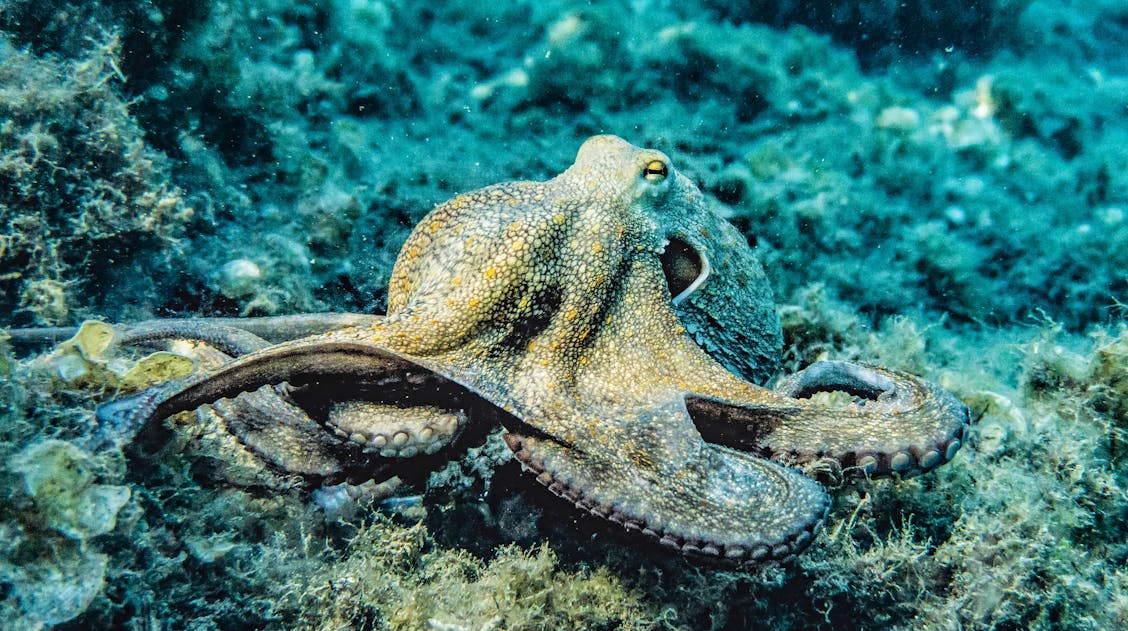
Testing Octopus Intelligence and Behaviors
Octopuses are fascinating creatures. They have an ethereal presence that captivates the interest of researchers as well as the general population. Currently, 300 species of octopus have been identified. Furthermore, researchers have found evidence of octopus ancestors in fossils that date back 328 million years.
Octopuses are extremely intelligent and have demonstrated that they can learn, play, and regenerate damaged tissues. They have also sparked interest in the biomedical and medicinal communities for producing bioactive compounds such as squid ink. Squid ink has been found to have antimicrobial and antioxidant properties.
In this article, we look at MDPI research which puts octopus intelligence to the test by analysing differences in their behavioural and problem-solving abilities.
Octopus features
Octopuses are cephalopods, which, translated from Greek to English, means head-foot. This refers to their unusual bodily structure, as their head is directly connected to their eight tentacles.
Furthermore, their eight tentacles each have clusters of neurons that act as a mini brain to control movement, touch, and taste independently from their central brain. In fact, two-thirds of octopus neurons are found outside of the central brain. Octopuses’ central brains are located between their eyes and have 30 differentiated lobes.
In addition, octopuses also have other strange anatomical characteristics; they have three hearts. Octopuses have blue blood due to the protein hemocyanin, which carries oxygen around the octopus’s body. Hemocyanin contains copper instead of iron, like mammal blood. It is more efficient at carrying oxygen in the deep ocean, where it’s cold and there are low concentrations of oxygen.
Although hemocyanin is more efficient at delivering oxygen to organs in these conditions, it’s not as effective as haemoglobin in normal conditions. To compensate for this, three hearts are required to effectively transport oxygen to the organs. One is responsible for circulating blood around the body, and the other two pump it past the gills to get oxygen.
Octopus behaviours
Octopuses have distinctive features that they can utilise for their protection. In dangerous situations, they can squirt water at intruders to scare them away. Moreover, they can also use their ink to camouflage themselves and hide from predators. They have also been reported to disguise themselves by mimicking algae to escape predators. Interestingly, some species of octopus have even been reported to use objects such as stones and coconut shells to camouflage themselves to elude predators.
Octopus hunting habits
Octopuses have interesting hunting habits; they use their specialised tentacles to detect, manipulate, and capture their prey. They feed on a wide variety of different food sources; however, their main food source is prey encased in hard shells, such as crustaceans, including crabs and shrimp
However, because of their intelligence and the adaptability of their tentacles, they have a variety of methods to capture their prey. Octopuses have an affinity for problem-solving, which is useful when faced with these situations.
One mechanism octopuses use is extractive foraging. Extractive foraging allows octopuses to explore the potential of their tentacles. In the wild, octopuses use their tentacles, laced with suckers, to stick to and pry open hard sells. Another mechanism they use, if they are unsuccessful, includes using their salivary glands as well as their tiny teeth, known as radula, to drill through the hard shell. In addition, they can also use water as a tool by squirting it to reach hard-to-access food sources. This type of hunting is known as extractive foraging.
Extractive foraging allows octopuses to explore the potential of their tentacles. This has been observed in nature and in a controlled environment. In controlled environments, octopuses have learned to open jars and boxes to access prey.
Octopus extractive foraging
A recent study published in Biology capitalized on this approach to investigate the behavioural responses of octopuses in response to an extractive foraging task. The researchers tested the octopuses on their problem-solving abilities in a series of eight consecutive experiments over 12 days.
This series of experiments were used to characterize the octopuses as neophilic and neophobic based on their reaction to new objects and their tendency to approach them. Animals described as neophilic show more interest in novel objects and willingly approach them. However, animals described as neophobic have an aversion to novel objects and tend to avoid them. In the initial experiments, researchers introduced a live crab to the octopuses and measured the time taken to attack; they referred to this as the latency period
After these experiments, researchers introduced the octopuses to a puzzle box. The researchers focused on four aspects of the octopus’s attack strategy; this included the time taken to approach the box, first contact with the box, opening of the box, and seizure of the crab.
The experiments then evolved by introducing novel objects and monitoring their reactions to them. As expected, the researchers found that neophilic octopuses had shorter latency periods approaching the puzzle box compared to neophilic octopuses. In addition, they also had a higher probability of solving the puzzle box.
Next, the researchers tested the octopuses on an individual learning activity, using the animal’s preferred novel object to investigate their learning abilities. The researchers paired a stimulus, a mild electric shock, to the object and monitored the time taken for the octopus to approach the object.
Octopuses problem solving abilities
They identified that the octopuses which demonstrated shorter latency periods for the novel object task had a better performance for the individual learning task. However, the researchers also noted that octopuses with the strongest neophilic behaviours did not solve the puzzle earlier than the other participants. This suggests that neophilic behaviour can cause suboptimal performance at some stages of the problem-solving process.
An interesting finding from this study was that the season and fishing site where the octopuses were collected from influenced octopus’s behaviour differently. Moreover, the researchers found that octopuses collected in spring/summer possessed more neophilic behaviours than those captured in autumn/winter. They also identified differences in brain size in octopuses collected from different geographical locations.
Octopus ink for biomedical purposes
Another interesting quality of octopuses is their ink, which they use to ward off predators. However, their ink has also been identified as having antimicrobial properties as well as other beneficial medicinal properties.
A recent study published in Marine Drugs investigated bioactive compounds found in O. vulgaris octopus ink. The researchers quantified a wide range of peptides and proteins in the ink of the octopus species O. vulgaris. These proteins were found to release a wide range of potential bioactive compounds that could be used in future biomedical research. These bioactive compounds have antimicrobial, antiviral, and anticancer properties, and could act as potential immune stimulators.
Summary
The behaviours and qualities of octopuses are extremely interesting. Research has demonstrated that octopuses are very intelligent and are continuing to evolve new techniques to survive. Interestingly, season and geographical location can influence the learning and behavioural responses of octopuses. In addition, their ink holds promise for biomedical research and requires further research to understand its full potential.
Here at MDPI, we have a wide variety of journals where you can publish research on a range of subjects. Please see our full journal list for more information.










